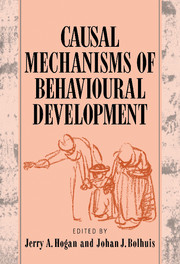Book contents
- Frontmatter
- Contents
- List of contributors
- Foreword: Introducing Jaap Kruijt
- Preface
- Part one Introduction
- Part two Development of perceptual and motor mechanisms
- Part three Development of behaviour systems
- 8 The ontogeny of social displays: interplay between motor development, development of motivational systems and social experience
- 9 Psychobiology of the early mother–young relationship
- 10 Development of behavior systems
- Part four Development of cognition
- Part five Learning and development
- Author index
- Subject index
10 - Development of behavior systems
Published online by Cambridge University Press: 19 January 2010
- Frontmatter
- Contents
- List of contributors
- Foreword: Introducing Jaap Kruijt
- Preface
- Part one Introduction
- Part two Development of perceptual and motor mechanisms
- Part three Development of behaviour systems
- 8 The ontogeny of social displays: interplay between motor development, development of motivational systems and social experience
- 9 Psychobiology of the early mother–young relationship
- 10 Development of behavior systems
- Part four Development of cognition
- Part five Learning and development
- Author index
- Subject index
Summary
I begin this chapter with a brief discussion of what I mean by a behavior system, and then use the dustbathing, hunger, aggression, and sex systems of chickens to illustrate how such systems develop. Using these examples plus comparable information from investigations of mammalian behavior, I next consider the questions of whether there are any general differences between the development of perceptual and motor mechanisms and between social and non-social behavior systems. In the context of social behavior systems, I review some ways in which early experience can have far-reaching effects. Finally, I look at the development of interactions among behavior systems, and ask whether any new principles are necessary to understand this complex process.
Behavior systems
A definition of a behavior system and its components is given in Chapter 1, and a depiction of the concept is presented there in Figure 1.1 (p. 6). A more extensive discussion of this concept and many of the other issues considered in this chapter can be found in Hogan (1988). In brief, a behavior system consists of an organization of its components: perceptual, motor, and central behavior mechanisms. Each of these components is also organized. The study of development comprises: (1) describing the changes in both the organization of the components themselves and the organization of the system as whole (i.e. the connections among the behavior mechanisms), and (2) investigating the causes of those changes.
- Type
- Chapter
- Information
- Causal Mechanisms of Behavioural Development , pp. 242 - 264Publisher: Cambridge University PressPrint publication year: 1994
- 6
- Cited by



